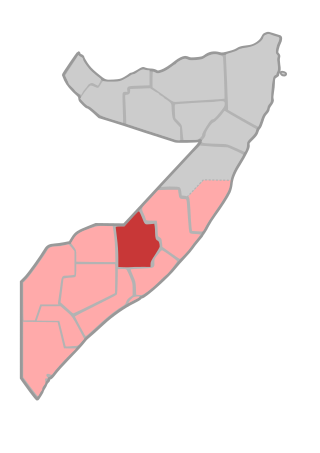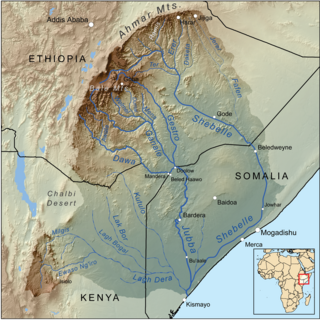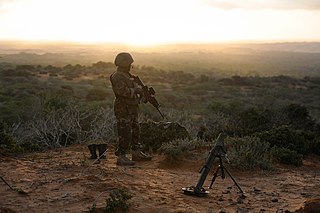Related Research Articles

Somalia is a country located in the Horn of Africa which officially consists of the intra-46th meridian east territory, the seven federal member states, namely Galmudug, Hirshabelle, Jubaland, South West, Puntland, and the municipality of Benadir. It is bordered by Ethiopia to the west, the Gulf of Aden to the north, the Somali Sea and Guardafui Channel to the east, and Kenya to the southwest. With a land area of 637,657 square kilometers, Somalia's terrain consists mainly of plateaus, plains and highlands. Its coastline is more than 3,333 kilometers in length, the longest of mainland Africa. It has been described as being roughly shaped "like a tilted number seven".

Hiran is an administrative region (gobol) in central Somalia and part of the Hirshabelle State.

Lower Shabelle is an administrative region (gobol) in southern Somalia.

Middle Juba is an administrative region (gobol) in southern Somalia. With its capital at Bu'aale, it is located in the autonomous Jubaland region.

The Jubba River or Juba River is a river in southern Somalia which flows through the region of Jubaland. It begins at the border with Ethiopia, where the Dawa and Ganale Dorya rivers meet, and flows directly south to the Somali Sea, where it empties at the Goobweyn juncture. The Jubba basin covers an area of 749,000 km2 (289,000 sq mi). The Somali regional state of Jubaland, formerly called Trans-Juba, is named after the river.

The Shebelle River also known historically as the Nile of Mogadishu, begins in the highlands of Ethiopia, and then flows southeast into Somalia towards Mogadishu. Near Mogadishu, it turns sharply southwest, where it follows the coast. Below Mogadishu, the river becomes seasonal. During most years, the river dries up near the mouth of the Jubba River, while in seasons of heavy rainfall, the river actually reaches the Jubba and thus the ocean.
The Reer Barre are a tribe in the Gedo region of the Ethiopia-Ogaden region on the Shabele River, near Somalia, who currently speak Somali. Historically farmers, a small number of Reer Barre are pastoralist, mostly keeping cows and goats and are usually residents of eastern cities of Ethiopia, such as Jijiga, Gode, Kelafo, Far-libah, Feerfeer, Mustahiil, along with more cities and towns in different parts of the Somali Regional state of Ethiopia. These tribes are unkown to the government of Ethiopia so far, regardless of the country's ethnic based federalism who has no stock of its ethnic group. They are a large family who also have a large population in the Shabelle region, Somalia. Reer means "family" and Barre is a name, altogether meaning "Barre family". They are descendants of Barre Abdille.

The Garre are a prominent Somali clan that traces its lineage back to Samaale, who is believed to have originated from the Arabian Peninsula through Aqiil Abu Talib. The Garre clan is considered to be a sub-clan of the Digil-Rahanweyn clan family, which is part of the larger Rahanweyn clan. However, genealogically, they are descended from Gardheere Samaale. The Garre are also categorized as southern Hawiye as well.

The Jubba Valley is a valley in East Africa.
Ferfer is a woreda in the Somali Region of Ethiopia, named after its major town, Ferfer. Part of the Gode Zone, Ferfer is bordered on the west by Mustahil, on the north by the Korahe Zone, and on the east and south by the Provisional Administrative Line with Somalia. The Shebelle River flows through this woreda.
The Somali Bantus are a Bantu ethnic minority group in Somalia who primarily reside in the southern part of the country, primarily near the Jubba and Shabelle rivers. The Somali Bantus are descendants of enslaved peoples from various Bantu ethnic groups from Southeast Africa, particularly from Mozambique, Malawi, and Tanzania. The East African slave trade was not eliminated until the early parts of the 20th century.

Uegitglanis zammaranoi is the only species of catfish in the genus Uegitglanis of the family Clariidae. It is endemic to Somalia, where it only occurs in caves near the Jubba and the Shebelle Rivers. This species grows to about 10.1 cm (4.0 in) in total length.

Luuq is a city in the southwestern Gedo province of Somalia. It is one of the older settlements in the area. It is the seat of the Luuq District. The town is located in a bend of the Juba River, where the watercourse flows down from north to south in a horseshoe shape. Luuq is also known as Luuq Gan naane.

Bardera Polytechnic is a non-profit tertiary polytechnic education centre located in Bardera, Somalia. The college's full name is Bardera Polytechnic College (BPC). Bardera Polytechnic is the first post-secondary institution in Bardera and the larger Gedo region. Bardera Polytechnic is the first post-civil war vocational training school in southern Somalia.

The Beledweyne bombing was a bombing targeting Medina Hotel in Beledweyne, Somalia killing 57 and injuring 307 others.

Operation Indian Ocean was a joint military operation between the Somali military, AMISOM and the United States military against the Al-Shabaab militant group aimed at eliminating the remaining insurgent-held areas in southern Somalia. It officially began in August 2014.

Ganale Doria is a dam located near Genale on the river Shabelle. It was built in the south of Somalia in the 1920s along with an extensive network of canals. The dam was strongly promoted by Cesare Maria De Vecchi - Italian governor of Italian Somalia from 1924 to 1928 - in order to provide water for irrigation of a vast territory between Genale, Merca and Vittorio di Africa, to be given in concession to colonists.

The Jubba Basin, also called Goobweyn Hoose, is a drainage outlet in Jubaland, Somalia and is the point at which the River Jubba meets the Somali Sea. Since the Shebelle River's outlet joins Jubba as a tributary, it is also the outlet of the Shebelle River.

The Somali Acacia–Commiphora bushlands and thickets is a semi-arid tropical grasslands, savannas, and shrublands ecoregion in the Horn of Africa. It is home to diverse communities of plants and animals, including several endemic species.
The Tunni Sultanate was a Somali Muslim Sultanate located in southwestern Somalia, south of the Shabelle river. It was ruled by the Tunni people, who speak the Af-Tunni language. The historical Tunni area corresponds to the modern-day Lower Shabelle region.